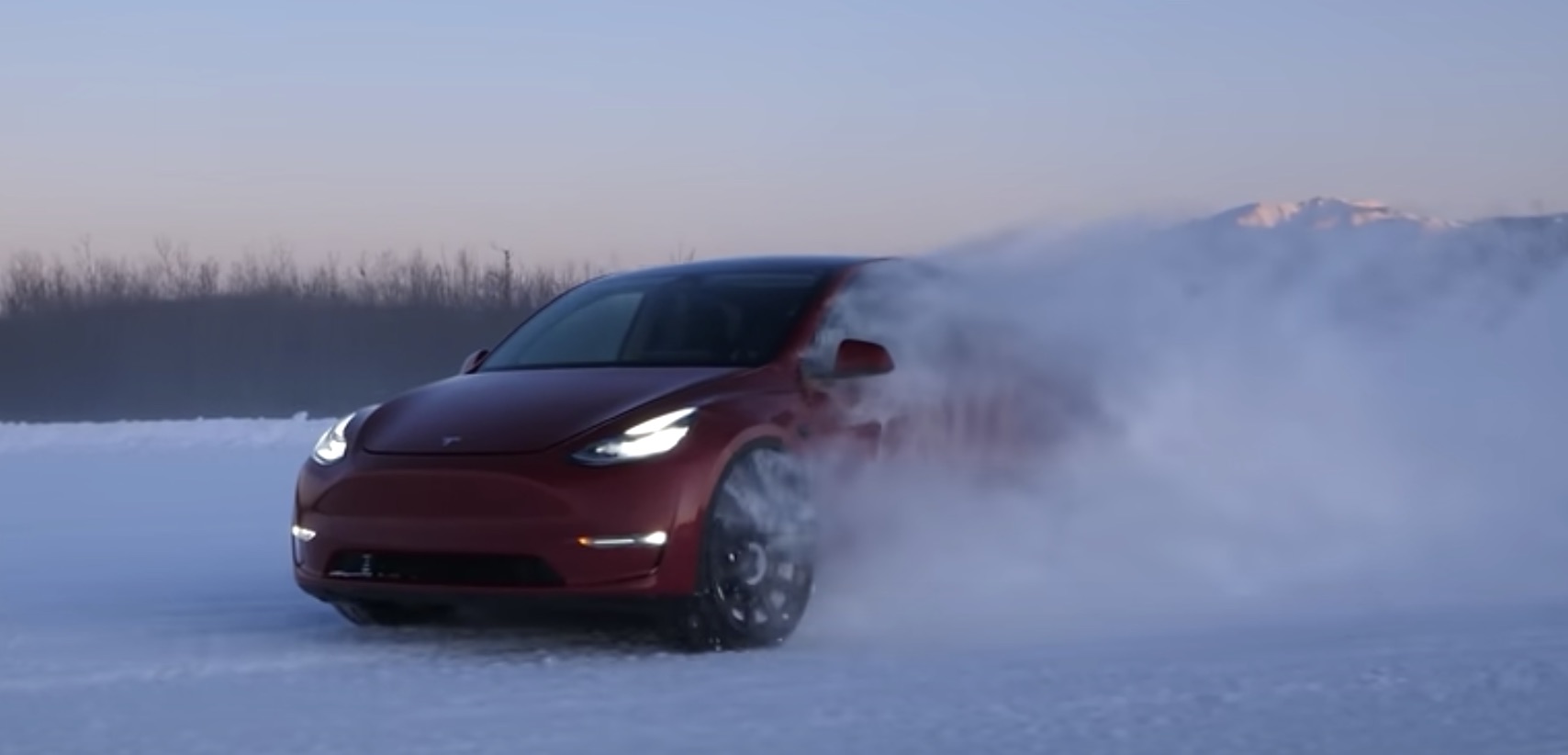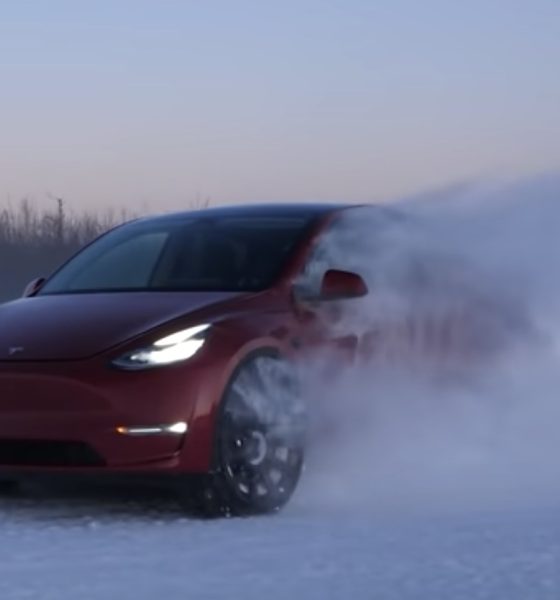

News
Tesla to roll out software update to fix windshield defrosting issue on 26k vehicles
Tesla is rolling out an over-the-air software update that would allow the company to address a windshield defrosting issue present in vehicles that are equipped with a heat pump. A total of 26,681 vehicles are affected by the issue, according to the National Highway Traffic Safety Administration’s (NHTSA) Safety Recall Report.
Vehicles that are part of the “recall” include 2021-2022 Tesla Model S, 2020-2022 Tesla Model Y, 2021-2022 Tesla Model 3, and 2021-2022 Tesla Model X. The US regulator noted in its Safety Recall Report that a software error in the affected vehicles may cause a valve at the cars’ heat pumps to open unintentionally, resulting in refrigerant being trapped inside the evaporator. This could adversely affect a vehicle’s defrosting performance.
While the issue is quite notable, Tesla notes that it is not aware of any crashes, injuries, or fatalities related to the affected vehicles’ heat pump issue.
A chronology of the heat pump issue was outlined in the NHTSA’s Safety Recall Report. As per the document, Tesla began rolling out firmware release 2021.44 and subsequent releases through firmware release 2021.44.30.6 to affected vehicles on or about December 10, 2021. Later that month, the company started receiving complaints from customers about the loss of heating performance in extreme weather conditions.
An investigation to find the root cause of the issue was commenced then. By January 11, 2022, it was determined that the lack of software command to close the Electronic Expansion Valve (EXV) after communication interruptions in firmware release 2021.44 through 2021.44.30.6 was a potential cause of the problem. Software update 2021.44.30.7 and later releases, which reintroduced a software command to close the EXV, was rolled out on January 15, 2022, as a precautionary measure.
Tesla Model 3, Model Y HVAC investigation in Canada still ongoing after 171 consumer complaints
Following discussions with the NHTSA’s Office of Vehicle Safety Compliance and Transport Canada about consumer complaints, Tesla conducted tests to assess the compliance of new vehicles delivered with the software command found in firmware release 2021.44 through 2021.44.30.6. Unfortunately, the results of these tests revealed that new vehicles delivered with firmware release 2021.44 through 2021.44.30.6 may still present issues in worst-case scenarios.
After confirming the root cause of the issue, a recall determination was made for the affected vehicles on January 26, 2022, the final day of the compliance tests. The affected vehicle population for the recall was then expanded out of an abundance of caution on February 7, 2022, to incorporate vehicles that are currently running firmware release 2021.44 through 2021.44.30.6, but are yet to install firmware release 2021.44.30.7 or later.
The remedy for the issue was outlined in the NHTSA’s Safety Recall Notice. As per the document, the fix for the issue would be rolled out through firmware release 2021.44.30.7. The update, similar to Tesla’s other key patches for its vehicles, would be released over-the-air and completely free of charge.
“Firmware release 2021.44.30.7 and later releases remedy the condition by reintroducing a software command to close the EXV, thereby preventing refrigerant from entering the evaporator. No further action is necessary from owners whose vehicles are equipped with firmware release 2021.44.30.7 or a later release.
“Tesla does not plan to include a statement in the Part 577 owner notification about reimbursement for pre-notice repairs to owners since all of the affected vehicles remain covered under the new vehicle warranty, and owners will receive the remedy free of charge with an OTA firmware release.”
The NHTSA’s Safety Recall Report for Tesla’s heat pump issue can be viewed below.
RCLRPT-22V050-2023 by Simon Alvarez on Scribd
Don’t hesitate to contact us with news tips. Just send a message to simon@teslarati.com to give us a heads up.

News
Tesla (TSLA) receives “Buy” rating and $551 PT from Canaccord Genuity
He also maintained a “Buy” rating for TSLA stock over the company’s improving long-term outlook, which is driven by autonomy and robotics.

Canaccord Genuity analyst George Gianarikas raised his Tesla (NASDAQ:TSLA) price target from $482 to $551. He also maintained a “Buy” rating for TSLA stock over the company’s improving long-term outlook, which is driven by autonomy and robotics.
The analyst’s updated note
Gianarikas lowered his 4Q25 delivery estimates but pointed to several positive factors in the Tesla story. He noted that EV adoption in emerging markets is gaining pace, and progress in FSD and the Robotaxi rollout in 2026 represent major upside drivers. Further progress in the Optimus program next year could also add more momentum for the electric vehicle maker.
“Overall, yes, 4Q25 delivery expectations are being revised lower. However, the reset in the US EV market is laying the groundwork for a more durable and attractive long-term demand environment.
“At the same time, EV penetration in emerging markets is accelerating, reinforcing Tesla’s potential multi‑year growth runway beyond the US. Global progress in FSD and the anticipated rollout of a larger robotaxi fleet in 2026 are increasingly important components of the Tesla equity story and could provide sentiment tailwinds,” the analyst wrote.
Tesla’s busy 2026
The upcoming year would be a busy one for Tesla, considering the company’s plans and targets. The autonomous two-seat Cybercab has been confirmed to start production sometime in Q2 2026, as per Elon Musk during the 2025 Annual Shareholder Meeting.
Apart from this, Tesla is also expected to unveil the next-generation Roadster on April 1, 2026. Tesla is also expected to start high-volume production of the Tesla Semi in Nevada next year.
Apart from vehicle launches, Tesla has expressed its intentions to significantly ramp the rollout of FSD to several regions worldwide, such as Europe. Plans are also underway to launch more Robotaxi networks in several more key areas across the United States.
News
Waymo sues Santa Monica over order to halt overnight charging sessions
In its complaint, Waymo argued that its self-driving cars’ operations do not constitute a public nuisance, and compliance with the city’s order would cause the company irreparable harm.

Waymo has filed a lawsuit against the City of Santa Monica in Los Angeles County Superior Court, seeking to block an order that requires the company to cease overnight charging at two facilities.
In its complaint, Waymo argued that its self-driving cars’ operations do not constitute a public nuisance, and compliance with the city’s order would cause the company irreparable harm.
Nuisance claims
As noted in a report from the Los Angeles Times, Waymo’s two charging sites at Euclid Street and Broadway have operated for about a year, supporting the company’s growing fleet with round-the-clock activity. Unfortunately, this has also resulted in residents in the area reportedly being unable to sleep due to incessant beeping from self-driving taxis that are moving in and out of the charging stations around the clock.
Frustrated residents have protested against the Waymos by blocking the vehicles’ paths, placing cones, and “stacking” cars to create backups. This has also resulted in multiple calls to the police.
Last month, the city issued an order to Waymo and its charging partner, Voltera, to cease overnight operations at the charging locations, stating that the self-driving vehicles’ activities at night were a public nuisance. A December 15 meeting yielded no agreement on mitigations like software rerouting. Waymo proposed changes, but the city reportedly insisted that nothing would satisfy the irate residents.
“We are disappointed that the City has chosen an adversarial path over a collaborative one. The City’s position has been to insist that no actions taken or proposed by Waymo would satisfy the complaining neighbors and therefore must be deemed insufficient,” a Waymo spokesperson stated.
Waymo pushes back
In its legal complaint, Waymo stated that its “activities at the Broadway Facilities do not constitute a public nuisance.” The company also noted that it “faces imminent and irreparable harm to its operations, employees, and customers” from the city’s order. The suit also stated that the city was fully aware that the Voltera charging sites would be operating around the clock to support Waymo’s self-driving taxis.
The company highlighted over one million trips in Santa Monica since launch, with more than 50,000 rides starting or ending there in November alone. Waymo also criticized the city for adopting a contentious strategy against businesses.
“The City of Santa Monica’s recent actions are inconsistent with its stated goal of attracting investment. At a time when the City faces a serious fiscal crisis, officials are choosing to obstruct properly permitted investment rather than fostering a ‘ready for business’ environment,” Waymo stated.
News
Tesla FSD v14.2.2 is getting rave reviews from drivers
So far, early testers have reported buttery-smooth drives with confident performance, even at night or on twisty roads.

Tesla Full Self-Driving (Supervised) v14.2.2 is receiving positive reviews from owners, with several drivers praising the build’s lack of hesitation during lane changes and its smoother decision-making, among others.
The update, which started rolling out on Monday, also adds features like dynamic arrival pin adjustment. So far, early testers have reported buttery-smooth drives with confident performance, even at night or on twisty roads.
Owners highlight major improvements
Longtime Tesla owner and FSD user @BLKMDL3 shared a detailed 10-hour impression of FSD v14.2.2, noting that the system exhibited “zero lane change hesitation” and “extremely refined” lane choices. He praised Mad Max mode’s performance, stellar parking in locations including ticket dispensers, and impressive canyon runs even in dark conditions.
Fellow FSD user Dan Burkland reported an hour of FSD v14.2.2’s nighttime driving with “zero hesitations” and “buttery smooth” confidence reminiscent of Robotaxi rides in areas such as Austin, Texas. Veteran FSD user Whole Mars Catalog also demonstrated voice navigation via Grok, while Tesla owner Devin Olsen completed a nearly two-hour drive with FSD v14.2.2 in heavy traffic and rain with strong performance.
Closer to unsupervised
FSD has been receiving rave reviews, even from Tesla’s competitors. Xpeng CEO He Xiaopeng, for one, offered fresh praise for FSD v14.2 after visiting Silicon Valley. Following extended test drives of Tesla vehicles running the latest FSD software, He stated that the system has made major strides, reinforcing his view that Tesla’s approach to autonomy is indeed the proper path towards autonomy.
According to He, Tesla’s FSD has evolved from a smooth Level 2 advanced driver assistance system into what he described as a “near-Level 4” experience in terms of capabilities. While acknowledging that areas of improvement are still present, the Xpeng CEO stated that FSD’s current iteration significantly surpasses last year’s capabilities. He also reiterated his belief that Tesla’s strategy of using the same autonomous software and hardware architecture across private vehicles and robotaxis is the right long-term approach, as it would allow users to bypass intermediate autonomy stages and move closer to Level 4 functionality.








